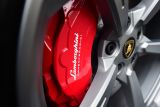A
Auto Express
Guest
Building the Lamborghini Urus was the price the company had to pay to help it continue to build supercars. After all, it worked for Porsche, so why shouldn't the Italians try it too? It's not Lamborghini's first SUV - the boxy, often forgotten LM002 was the ultimate off-roader of the 1980s and 1990s - but the Urus is aiming to take sales in what has become an intensely competitive market; the high-performance SUV sector.
The Urus arrived in the UK in 2018, and it's for sale alongside the company's Huracan and Aventador models, but it has very different specs to those two. For starters, it's front-engined, and it doesn't have a V10 or V12, instead, it gets a twin-turbo V8 that is also found in two of the Urus' closest rivals, the Porsche Cayenne Turbo and Bentley Bentayga. These three are at the pinnacle of performance SUV technology, while other rivals include the Range Rover Sport SVR, Audi SQ7 and Maserati Levante.
• Best SUVs to buy
Controversial looks help the Urus to stand out, and its mix of acute angles and sharp creases, high sides and small windows mean it certainly looks like no other SUV on the road. It has the performance to match the Lamborghini badge on the nose, though, as that engine is tuned to produce 641bhp, which gives the Urus a claimed 0-62mph time of 3.6 seconds. Top speed is rated at 190mph.

Lamborghini Urus - front tracking

Lamborghini Urus - interior black

Lamborghini Urus - rear static red

Lamborghini Urus - rear action

Lamborghini Urus - boot

Lamborghini Urus - brake disk

Lamborghini Urus - front cornering

Lamborghini Urus - rear off-road

Lamborghini Urus - rear seats

Lamborghini Urus - cabin
Like Lamborghini's supercars, and ideal as it's an SUV, there's a four-wheel-drive transmission, while a ZF-sourced 8-speed automatic gearbox helps get that power to the tyres. This set-up is designed to deliver unbreakable traction on the road, rather than off-road ability, although air-suspension can raise the car to help it deliver that if needed - Lamborghini also offers reprofiled front and rear bumpers to help boost approach and departure angles.
There's just one version of the Urus available at the moment, which has a price tag of around £160,000. But that's just the starting point to a catalogue of personalisation options available to customers. There are a range of wheel options, carbon fibre and leather packages for the cabin, additional tech and extra off-road equipment all designed to make the Urus as individual as you like.
Whatever spec you choose, the Urus delivers a driving experience that does the Lamborghini badge proud and makes it one of the most engaging performance SUVs you can buy.
You might approach the Lamborghini Urus thinking it’s a colossally inappropriate symbol of excessive consumption that proves the traditional car industry has nowhere left to go. Or you might think it’s a joyful celebration of the modern day automotive space race, where ultimate power and cutting-edge engineering brutally force the laws of physics into submission. Either way, it’s unlikely you’ll be unmoved by any encounter with the Urus – even the Porsche Cayenne Turbo didn’t manage to be this divisive when the idea of an SUV with supercar handling was mooted.
Having driven the Urus, it’s hard to imagine anyone failing to be impressed with its sheer size-defying pace in a straight line and around corners. Or its sheer drama and road presence – the Urus really does feel like a supercar on steroids, with your partner, kids and dog along for the ride.
The Lamborghini Urus is big, tall, and it weighs more than two tonnes. It also accelerates and handles exactly the way you’d expect from a Lamborghini, thanks to a monstrously powerful engine and seriously sophisticated suspension.
Leaving its phenomenally powerful V8 aside for a moment, the Urus’ platform with sophisticated 4x4 system is a good place to start. It's sourced from the Audi SQ7, but the Lamborghini SUV boasts active anti-roll bars that eradicate any lateral wallowing in corners – they slacken off to allow more freedom off-road – as well as rear wheel steering to help sharpen up turn-in responses. The driver can select drive modes with up to six settings using the Tamburo. That’s Lamborghini’s name for the array of controls on the centre console offering different chassis and powertrain presets for tarmac, sport and track driving, plus snow, gravel or sand.

Lamborghini Urus - front tracking

Lamborghini Urus - interior black

Lamborghini Urus - rear static red

Lamborghini Urus - rear action

Lamborghini Urus - boot

Lamborghini Urus - brake disk

Lamborghini Urus - front cornering

Lamborghini Urus - rear off-road

Lamborghini Urus - rear seats

Lamborghini Urus - cabin
The chassis tech all translates into a driving experience worthy of the Lamborghini name. Once you’re accustomed to the size of the beast, you can drive it as you would any modern performance car. Accurate and well weighted steering offers crisp turn-in, and the Urus corners impressively flat and hard with tremendous grip. It’s also amazingly agile, offering quick responses to direction changes while remaining reassuringly stable.
It’s all surprisingly effortless from behind the wheel. The 8-speed automatic gearbox operates seamlessly in the background, while massive carbon ceramic brakes bring the Urus to heel with dramatic efficiency on the road.
There is a price to pay for an SUV that handles like a sports car, however, and the ride is considerably firmer than the family might enjoy, with less than perfect tarmac transmitting quite a lot of noise and vibration into the cabin.
Engines, 0-60 acceleration and top speed
This is where the numbers get a little dizzying. Lamborghini has tweaked the Porsche Cayenne Turbo’s V8 for its installation here, hiking power to a monstrous 641bhp and raising torque to an incredible 850Nm. The result is a 0-62mph sprint of 3.6 seconds, and a claimed top speed of 190mph – accompanied by a suitably threatening bellow from the exhaust when you’ve selected the sportier drive modes.
The price of the Urus is around £160,000, but that figure will soon climb when customers seeking to personalise their car begin ticking more equipment on the extensive options list. It stands to reason that anyone spending so much on a car is unlikely to have financial issues when filling the tank, but with a quoted 22.2mpg on the combined cycle if driven gently, the chances are that even careful drivers will be filling up the 85-litre tank on a regular basis. Will anyone buy a Urus to drive it carefully? If they do, a range of over 400 miles is theoretically possible.

Lamborghini Urus - front tracking

Lamborghini Urus - interior black

Lamborghini Urus - rear static red

Lamborghini Urus - rear action

Lamborghini Urus - boot

Lamborghini Urus - brake disk

Lamborghini Urus - front cornering

Lamborghini Urus - rear off-road

Lamborghini Urus - rear seats

Lamborghini Urus - cabin
Emissions are unlikely to be high on the Urus buyer’s agenda either, which is just as well as a CO2 rating of 325g/km is not where most of the automotive industry is headed right now. There’s currently no hybrid option – although a plug-in version is on the way – and you can’t even have a stop/start system to reduce your tailpipe emissions in town.
• Best fast family cars on sale
There’s a big tax hit for anyone planning to use a Urus as a company car, with a benefit-in-kind rate at the highest level possible. That means the highest rate taxpayers would stump up around £30k annually. Annual road tax from years 2-6 is £475 with the luxury car surcharge, too, while the first-year rate of VED is £2,175.
That’s all before owners start wearing things out of course, and a Urus driven in the manner its maker intended is going to plough through highly expensive consumables like tyres and brake pads at a potentially ferocious rate.
Insurance groups
Group 50 insurance means the Lamborghini Urus falls into the most expensive category, as you would expect. Repair and replacement cost, coupled to extreme performance, is enough to give the average underwriter a cold sweat.
Depreciation
Some potentially good news for buyers is that Lamborghini has traditionally strong residuals, even on its previous best-seller the Gallardo. That said, the Urus will be churned out in greater numbers than any previous Lamborghini, with volumes of 3,500 cars annually mooted – around 14,000 Gallardos were made over a 10-year period.
The Lamborghini Urus is a big beast, taking up more space on the road than its Porsche Cayenne stablemate, although the Urus is significantly lower thanks to styling designed to ape the exoticism of Lamborghini’s more usual fare.
In truth, the Urus is a little more conventional than most Lamborghinis. Yes, it shares the dramatic styling cues, powerful haunches and ‘look at me’ showiness, but you can forget about the exotic scissor doors of the flagship supercars. Indeed the black plastic wheelarch extensions and lower body mouldings give the Urus something of a mass-produced flavour, as does the five-door layout. The dramatic surface creases do their best to hide it, but the ubiquitous two-box format of the generic large SUV is hard to disguise.
The overall effect is undeniably different and certainly eye-catching – with plenty of the regulation Lamborghini wow factor. The sense of exotic styling continues inside with an Aventador-inspired dashboard and console. A highlight feature is the Tamburo controls at the base of the centre console, this cluster of buttons and dials is designed with an aviation theme. The rest of the interior is lavished with supple leather and Alcantara trim which gives the car a suitably rich and luxurious ambience with sporty rather than opulent overtones.

Lamborghini Urus - front tracking

Lamborghini Urus - interior black

Lamborghini Urus - rear static red

Lamborghini Urus - rear action

Lamborghini Urus - boot

Lamborghini Urus - brake disk

Lamborghini Urus - front cornering

Lamborghini Urus - rear off-road

Lamborghini Urus - rear seats

Lamborghini Urus - cabin
The feel-good factor is helped along by the array of latest infotainment technology that’s another significant dividend of VW Group ownership. Naturally Lamborghini will encourage owners to express their own ‘bespoke’ styles through the Ad Personam scheme, which offers sufficient variety of colour and trim that Lamborghini says no two customer cars are ever likely to be identical.
Sat-nav, stereo and infotainment
As you’d expect in a £160k car from the VW Group, the Lamborghini Urus features some advanced infotainment kit including two big touchscreens, full connectivity and an optional Bang & Olufsen 1,700 Watt audio system. Individual TV screens are available for rear passengers, too.
There’s only the one five-door body style on offer, although you can specify your Lamborghini Urus with either a traditional 3-seater rear bench or individual rear chairs for two. There’s plenty of boot space, but while the car is undoubtedly luxuriously appointed, we’re not sure that passengers will appreciate the sporty ride as much as the driver. Stiffly sprung suspension is essential to keep the Urus glued to the tarmac at supercar speeds, but it means passengers must put up with plenty of noise and vibration over less than perfect tarmac. Other luxury SUVs place more emphasis on comfort and it shows.
You sit lower in the Urus than in most SUVs, and while this fits the Lamborghini’s sporting feel it does mean visibility is not as good. It can be hard to place the car in town or tight parking spaces, although it’s less of an issue on the open road.
Size
There’s no doubting the Lamborghini Urus has road presence. Even if it didn’t look quite so dramatic its 5,112mm length and 2,016mm width will turn heads. That said, it doesn’t take up quite as much space as the 5,1450mm x 2,224mm Bentley Bentayga. The Urus is also considerably lower than the Bentayga with a 1,638mm roof height compared to the 1,742mm Bentley.
Leg room, head room & passenger space
There’s plenty of room in the Lamborghini’s front seats, but the sloping, low-roofed body extracts a price in the back where both headroom and legroom for six-footers is in short supply. Additionally, the narrow window glass and relatively low seating position can make the rear seats feel a little claustrophobic – that’s quite at odds with the light and airy feel of many luxury SUV rivals.

Lamborghini Urus - front tracking

Lamborghini Urus - interior black

Lamborghini Urus - rear static red

Lamborghini Urus - rear action

Lamborghini Urus - boot

Lamborghini Urus - brake disk

Lamborghini Urus - front cornering

Lamborghini Urus - rear off-road

Lamborghini Urus - rear seats

Lamborghini Urus - cabin
Boot
Folding the rear seats down liberates a load space of 1,596 litres, and even with the kids in the back you get 616 litres of boot volume. It’s definitely enough to make the Urus a practical – if expensive - option as daily transport.
While we’re unlikely to see Euro NCAP crash testing the Urus – it’s not a big enough seller – the fact Lamborghini has employed the Audi Q7/Porsche Cayenne platform ensures a level of engineering integrity that should reassure owners. The Q7 was awarded five stars under the Euro NCAP regime in 2019.
Additionally, the Lamborghini is offered with all the clever safety tech you find on Audi and Porsche flagship models, albeit much is available only as part of Lambo’s optional Advanced Driver Assistance Systems packages. There are three of these, named Urban Road, Full ADAS and Highway. The full package includes head-up display, emergency brake assist and lane-keeping assistance, and, of course, the inherent stability and performance of the Urus – used wisely – can do a lot to keep you out of trouble in the first place. Use it unwisely, and it may well be a different story!
Reliability prospects seem decent too, as much of the Urus’s hardware has already seen service in other VW Group products, whether that’s the engine, the suspension or electronics and infotainment systems. With all the gremlins ironed out already, will this be the most reliable Lamborghini in the marque’s history? Time will tell.
Perceived build quality is very good too, especially in the cabin where there’s even a hint of Germanic fit and finish beneath the flashy Lamborghini styling.
Warranty
A four-year unlimited mileage warranty is supplied with the Lamborghini Urus, which beats anything else within the VW Group.
Servicing
You’ll need to service your Urus annually or every 9,000 miles, and many customers are likely to take advantage of dealer packages to keep things simple.
Continue reading...
The Urus arrived in the UK in 2018, and it's for sale alongside the company's Huracan and Aventador models, but it has very different specs to those two. For starters, it's front-engined, and it doesn't have a V10 or V12, instead, it gets a twin-turbo V8 that is also found in two of the Urus' closest rivals, the Porsche Cayenne Turbo and Bentley Bentayga. These three are at the pinnacle of performance SUV technology, while other rivals include the Range Rover Sport SVR, Audi SQ7 and Maserati Levante.
• Best SUVs to buy
Controversial looks help the Urus to stand out, and its mix of acute angles and sharp creases, high sides and small windows mean it certainly looks like no other SUV on the road. It has the performance to match the Lamborghini badge on the nose, though, as that engine is tuned to produce 641bhp, which gives the Urus a claimed 0-62mph time of 3.6 seconds. Top speed is rated at 190mph.

Lamborghini Urus - front tracking

Lamborghini Urus - interior black

Lamborghini Urus - rear static red

Lamborghini Urus - rear action

Lamborghini Urus - boot

Lamborghini Urus - brake disk

Lamborghini Urus - front cornering

Lamborghini Urus - rear off-road

Lamborghini Urus - rear seats

Lamborghini Urus - cabin
Like Lamborghini's supercars, and ideal as it's an SUV, there's a four-wheel-drive transmission, while a ZF-sourced 8-speed automatic gearbox helps get that power to the tyres. This set-up is designed to deliver unbreakable traction on the road, rather than off-road ability, although air-suspension can raise the car to help it deliver that if needed - Lamborghini also offers reprofiled front and rear bumpers to help boost approach and departure angles.
There's just one version of the Urus available at the moment, which has a price tag of around £160,000. But that's just the starting point to a catalogue of personalisation options available to customers. There are a range of wheel options, carbon fibre and leather packages for the cabin, additional tech and extra off-road equipment all designed to make the Urus as individual as you like.
Whatever spec you choose, the Urus delivers a driving experience that does the Lamborghini badge proud and makes it one of the most engaging performance SUVs you can buy.
You might approach the Lamborghini Urus thinking it’s a colossally inappropriate symbol of excessive consumption that proves the traditional car industry has nowhere left to go. Or you might think it’s a joyful celebration of the modern day automotive space race, where ultimate power and cutting-edge engineering brutally force the laws of physics into submission. Either way, it’s unlikely you’ll be unmoved by any encounter with the Urus – even the Porsche Cayenne Turbo didn’t manage to be this divisive when the idea of an SUV with supercar handling was mooted.
Having driven the Urus, it’s hard to imagine anyone failing to be impressed with its sheer size-defying pace in a straight line and around corners. Or its sheer drama and road presence – the Urus really does feel like a supercar on steroids, with your partner, kids and dog along for the ride.
The Lamborghini Urus is big, tall, and it weighs more than two tonnes. It also accelerates and handles exactly the way you’d expect from a Lamborghini, thanks to a monstrously powerful engine and seriously sophisticated suspension.
Leaving its phenomenally powerful V8 aside for a moment, the Urus’ platform with sophisticated 4x4 system is a good place to start. It's sourced from the Audi SQ7, but the Lamborghini SUV boasts active anti-roll bars that eradicate any lateral wallowing in corners – they slacken off to allow more freedom off-road – as well as rear wheel steering to help sharpen up turn-in responses. The driver can select drive modes with up to six settings using the Tamburo. That’s Lamborghini’s name for the array of controls on the centre console offering different chassis and powertrain presets for tarmac, sport and track driving, plus snow, gravel or sand.

Lamborghini Urus - front tracking

Lamborghini Urus - interior black

Lamborghini Urus - rear static red

Lamborghini Urus - rear action

Lamborghini Urus - boot

Lamborghini Urus - brake disk

Lamborghini Urus - front cornering

Lamborghini Urus - rear off-road

Lamborghini Urus - rear seats

Lamborghini Urus - cabin
The chassis tech all translates into a driving experience worthy of the Lamborghini name. Once you’re accustomed to the size of the beast, you can drive it as you would any modern performance car. Accurate and well weighted steering offers crisp turn-in, and the Urus corners impressively flat and hard with tremendous grip. It’s also amazingly agile, offering quick responses to direction changes while remaining reassuringly stable.
It’s all surprisingly effortless from behind the wheel. The 8-speed automatic gearbox operates seamlessly in the background, while massive carbon ceramic brakes bring the Urus to heel with dramatic efficiency on the road.
There is a price to pay for an SUV that handles like a sports car, however, and the ride is considerably firmer than the family might enjoy, with less than perfect tarmac transmitting quite a lot of noise and vibration into the cabin.
Engines, 0-60 acceleration and top speed
This is where the numbers get a little dizzying. Lamborghini has tweaked the Porsche Cayenne Turbo’s V8 for its installation here, hiking power to a monstrous 641bhp and raising torque to an incredible 850Nm. The result is a 0-62mph sprint of 3.6 seconds, and a claimed top speed of 190mph – accompanied by a suitably threatening bellow from the exhaust when you’ve selected the sportier drive modes.
The price of the Urus is around £160,000, but that figure will soon climb when customers seeking to personalise their car begin ticking more equipment on the extensive options list. It stands to reason that anyone spending so much on a car is unlikely to have financial issues when filling the tank, but with a quoted 22.2mpg on the combined cycle if driven gently, the chances are that even careful drivers will be filling up the 85-litre tank on a regular basis. Will anyone buy a Urus to drive it carefully? If they do, a range of over 400 miles is theoretically possible.

Lamborghini Urus - front tracking

Lamborghini Urus - interior black

Lamborghini Urus - rear static red

Lamborghini Urus - rear action

Lamborghini Urus - boot

Lamborghini Urus - brake disk

Lamborghini Urus - front cornering

Lamborghini Urus - rear off-road

Lamborghini Urus - rear seats

Lamborghini Urus - cabin
Emissions are unlikely to be high on the Urus buyer’s agenda either, which is just as well as a CO2 rating of 325g/km is not where most of the automotive industry is headed right now. There’s currently no hybrid option – although a plug-in version is on the way – and you can’t even have a stop/start system to reduce your tailpipe emissions in town.
• Best fast family cars on sale
There’s a big tax hit for anyone planning to use a Urus as a company car, with a benefit-in-kind rate at the highest level possible. That means the highest rate taxpayers would stump up around £30k annually. Annual road tax from years 2-6 is £475 with the luxury car surcharge, too, while the first-year rate of VED is £2,175.
That’s all before owners start wearing things out of course, and a Urus driven in the manner its maker intended is going to plough through highly expensive consumables like tyres and brake pads at a potentially ferocious rate.
Insurance groups
Group 50 insurance means the Lamborghini Urus falls into the most expensive category, as you would expect. Repair and replacement cost, coupled to extreme performance, is enough to give the average underwriter a cold sweat.
Depreciation
Some potentially good news for buyers is that Lamborghini has traditionally strong residuals, even on its previous best-seller the Gallardo. That said, the Urus will be churned out in greater numbers than any previous Lamborghini, with volumes of 3,500 cars annually mooted – around 14,000 Gallardos were made over a 10-year period.
The Lamborghini Urus is a big beast, taking up more space on the road than its Porsche Cayenne stablemate, although the Urus is significantly lower thanks to styling designed to ape the exoticism of Lamborghini’s more usual fare.
In truth, the Urus is a little more conventional than most Lamborghinis. Yes, it shares the dramatic styling cues, powerful haunches and ‘look at me’ showiness, but you can forget about the exotic scissor doors of the flagship supercars. Indeed the black plastic wheelarch extensions and lower body mouldings give the Urus something of a mass-produced flavour, as does the five-door layout. The dramatic surface creases do their best to hide it, but the ubiquitous two-box format of the generic large SUV is hard to disguise.
The overall effect is undeniably different and certainly eye-catching – with plenty of the regulation Lamborghini wow factor. The sense of exotic styling continues inside with an Aventador-inspired dashboard and console. A highlight feature is the Tamburo controls at the base of the centre console, this cluster of buttons and dials is designed with an aviation theme. The rest of the interior is lavished with supple leather and Alcantara trim which gives the car a suitably rich and luxurious ambience with sporty rather than opulent overtones.

Lamborghini Urus - front tracking

Lamborghini Urus - interior black

Lamborghini Urus - rear static red

Lamborghini Urus - rear action

Lamborghini Urus - boot

Lamborghini Urus - brake disk

Lamborghini Urus - front cornering

Lamborghini Urus - rear off-road

Lamborghini Urus - rear seats

Lamborghini Urus - cabin
The feel-good factor is helped along by the array of latest infotainment technology that’s another significant dividend of VW Group ownership. Naturally Lamborghini will encourage owners to express their own ‘bespoke’ styles through the Ad Personam scheme, which offers sufficient variety of colour and trim that Lamborghini says no two customer cars are ever likely to be identical.
Sat-nav, stereo and infotainment
As you’d expect in a £160k car from the VW Group, the Lamborghini Urus features some advanced infotainment kit including two big touchscreens, full connectivity and an optional Bang & Olufsen 1,700 Watt audio system. Individual TV screens are available for rear passengers, too.
There’s only the one five-door body style on offer, although you can specify your Lamborghini Urus with either a traditional 3-seater rear bench or individual rear chairs for two. There’s plenty of boot space, but while the car is undoubtedly luxuriously appointed, we’re not sure that passengers will appreciate the sporty ride as much as the driver. Stiffly sprung suspension is essential to keep the Urus glued to the tarmac at supercar speeds, but it means passengers must put up with plenty of noise and vibration over less than perfect tarmac. Other luxury SUVs place more emphasis on comfort and it shows.
You sit lower in the Urus than in most SUVs, and while this fits the Lamborghini’s sporting feel it does mean visibility is not as good. It can be hard to place the car in town or tight parking spaces, although it’s less of an issue on the open road.
Size
There’s no doubting the Lamborghini Urus has road presence. Even if it didn’t look quite so dramatic its 5,112mm length and 2,016mm width will turn heads. That said, it doesn’t take up quite as much space as the 5,1450mm x 2,224mm Bentley Bentayga. The Urus is also considerably lower than the Bentayga with a 1,638mm roof height compared to the 1,742mm Bentley.
Leg room, head room & passenger space
There’s plenty of room in the Lamborghini’s front seats, but the sloping, low-roofed body extracts a price in the back where both headroom and legroom for six-footers is in short supply. Additionally, the narrow window glass and relatively low seating position can make the rear seats feel a little claustrophobic – that’s quite at odds with the light and airy feel of many luxury SUV rivals.

Lamborghini Urus - front tracking

Lamborghini Urus - interior black

Lamborghini Urus - rear static red

Lamborghini Urus - rear action

Lamborghini Urus - boot

Lamborghini Urus - brake disk

Lamborghini Urus - front cornering

Lamborghini Urus - rear off-road

Lamborghini Urus - rear seats

Lamborghini Urus - cabin
Boot
Folding the rear seats down liberates a load space of 1,596 litres, and even with the kids in the back you get 616 litres of boot volume. It’s definitely enough to make the Urus a practical – if expensive - option as daily transport.
While we’re unlikely to see Euro NCAP crash testing the Urus – it’s not a big enough seller – the fact Lamborghini has employed the Audi Q7/Porsche Cayenne platform ensures a level of engineering integrity that should reassure owners. The Q7 was awarded five stars under the Euro NCAP regime in 2019.
Additionally, the Lamborghini is offered with all the clever safety tech you find on Audi and Porsche flagship models, albeit much is available only as part of Lambo’s optional Advanced Driver Assistance Systems packages. There are three of these, named Urban Road, Full ADAS and Highway. The full package includes head-up display, emergency brake assist and lane-keeping assistance, and, of course, the inherent stability and performance of the Urus – used wisely – can do a lot to keep you out of trouble in the first place. Use it unwisely, and it may well be a different story!
Reliability prospects seem decent too, as much of the Urus’s hardware has already seen service in other VW Group products, whether that’s the engine, the suspension or electronics and infotainment systems. With all the gremlins ironed out already, will this be the most reliable Lamborghini in the marque’s history? Time will tell.
Perceived build quality is very good too, especially in the cabin where there’s even a hint of Germanic fit and finish beneath the flashy Lamborghini styling.
Warranty
A four-year unlimited mileage warranty is supplied with the Lamborghini Urus, which beats anything else within the VW Group.
Servicing
You’ll need to service your Urus annually or every 9,000 miles, and many customers are likely to take advantage of dealer packages to keep things simple.
Continue reading...
